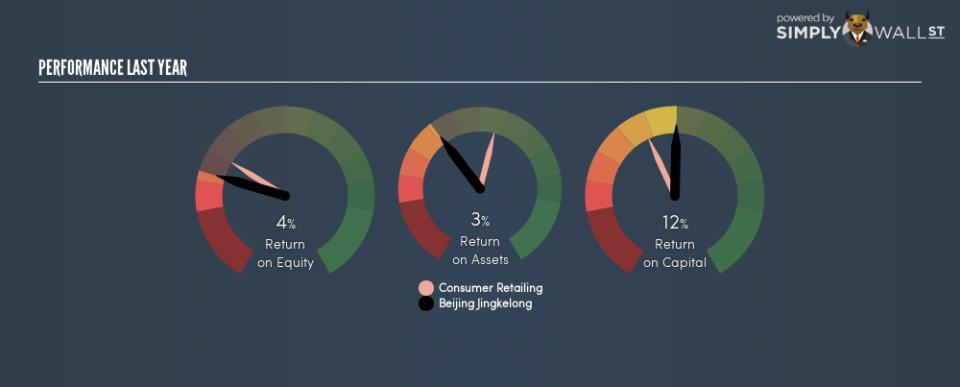Why We’re Not Impressed By Beijing Jingkelong Company Limited’s (HKG:814) 12% ROCE

Today we’ll look at Beijing Jingkelong Company Limited (HKG:814) and reflect on its potential as an investment. To be precise, we’ll consider its Return On Capital Employed (ROCE), as that will inform our view of the quality of the business.
First up, we’ll look at what ROCE is and how we calculate it. Next, we’ll compare it to others in its industry. Last but not least, we’ll look at what impact its current liabilities have on its ROCE.
Understanding Return On Capital Employed (ROCE)
ROCE is a metric for evaluating how much pre-tax income (in percentage terms) a company earns on the capital invested in its business. All else being equal, a better business will have a higher ROCE. Overall, it is a valuable metric that has its flaws. Author Edwin Whiting says to be careful when comparing the ROCE of different businesses, since ‘No two businesses are exactly alike.’
How Do You Calculate Return On Capital Employed?
Analysts use this formula to calculate return on capital employed:
Return on Capital Employed = Earnings Before Interest and Tax (EBIT) ÷ (Total Assets – Current Liabilities)
Or for Beijing Jingkelong:
0.12 = CN¥296m ÷ (CN¥7.7b – CN¥5.5b) (Based on the trailing twelve months to September 2018.)
Therefore, Beijing Jingkelong has an ROCE of 12%.
Check out our latest analysis for Beijing Jingkelong
Want to help shape the future of investing tools and platforms? Take the survey and be part of one of the most advanced studies of stock market investors to date.
Is Beijing Jingkelong’s ROCE Good?
ROCE can be useful when making comparisons, such as between similar companies. In our analysis, Beijing Jingkelong’s ROCE is meaningfully higher than the 10% average in the Consumer Retailing industry. We would consider this a positive, as it suggests it is using capital more effectively than other similar companies. Regardless of where Beijing Jingkelong sits next to its industry, its ROCE in absolute terms appears satisfactory, and this company could be worth a closer look.
In our analysis, Beijing Jingkelong’s ROCE appears to be 12%, compared to 3 years ago, when its ROCE was 9.0%. This makes us think about whether the company has been reinvesting shrewdly.
It is important to remember that ROCE shows past performance, and is not necessarily predictive. ROCE can be deceptive for cyclical businesses, as returns can look incredible in boom times, and terribly low in downturns. This is because ROCE only looks at one year, instead of considering returns across a whole cycle. What happens in the future is pretty important for investors, so we have prepared a free report on analyst forecasts for Beijing Jingkelong.
How Beijing Jingkelong’s Current Liabilities Impact Its ROCE
Short term (or current) liabilities, are things like supplier invoices, overdrafts, or tax bills that need to be paid within 12 months. Due to the way ROCE is calculated, a high level of current liabilities makes a company look as though it has less capital employed, and thus can (sometimes unfairly) boost the ROCE. To check the impact of this, we calculate if a company has high current liabilities relative to its total assets.
Beijing Jingkelong has total liabilities of CN¥5.5b and total assets of CN¥7.7b. Therefore its current liabilities are equivalent to approximately 72% of its total assets. This is admittedly a high level of current liabilities, improving ROCE substantially.
What We Can Learn From Beijing Jingkelong’s ROCE
This ROCE is pretty good, but remember that it would look less impressive with fewer current liabilities. But note: Beijing Jingkelong may not be the best stock to buy. So take a peek at this free list of interesting companies with strong recent earnings growth (and a P/E ratio below 20).
If you are like me, then you will not want to miss this free list of growing companies that insiders are buying.
To help readers see past the short term volatility of the financial market, we aim to bring you a long-term focused research analysis purely driven by fundamental data. Note that our analysis does not factor in the latest price-sensitive company announcements.
The author is an independent contributor and at the time of publication had no position in the stocks mentioned. For errors that warrant correction please contact the editor at editorial-team@simplywallst.com.



